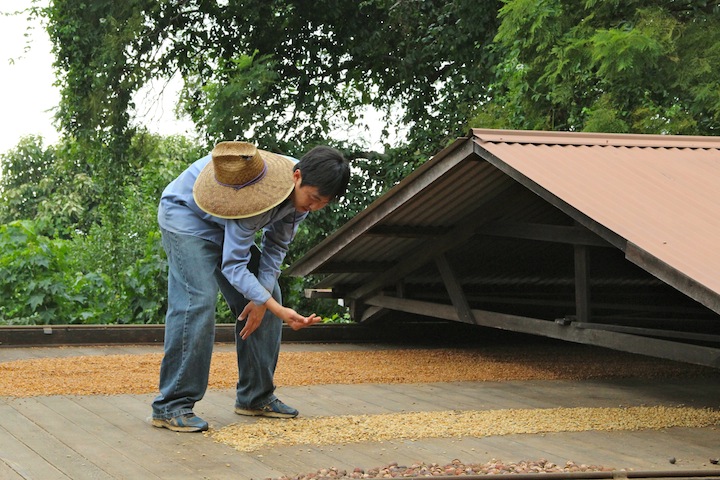
Processing
Processing Kona coffee beans, from harvesting the cherries on the trees to roasting the beans, is an extremely labor-intensive process. Coffee cherries, red when they’re at the peak of their maturity, are picked by hand from the months of late August to January. The cherries are fermented and washed in clean, fresh water. Then wet milling separates the beans from the outer skin. The beans are then dried. Next they are dry milled to separate the parchment skin from the green beans. And finally the green beans are roasted and bagged.
Select Picking
Due to the uneven terrain in Kona, coffee cherries (beans) here must be handpicked. Machine pickers are unable to operate on the steep rocky hillsides. Consequently adding quality to the end product. Although it is much more labor intensive picking coffee by hand, the coffee picked is of higher quality. Only the ripe beans are chosen, the others left to ripen and picked later when fully developed.
Wet Milling
First, the freshly harvested cherries are passed through a pulping machine to separate the skin and pulp from the bean.
The cherries are poured into large tanks of water. The beans are separated by weight. The heavier ripe beans sink to the bottom, while lighter beans float to the top. The lighter beans are then removed. They are also separated by size.
After separation, the beans are transported to large, water-filled fermentation tanks. Depending on a combination of factors such as the condition of the beans, the climate and the altitude they will remain in these tanks for anywhere from 12 to 48 hours. This will remove the slick layer of mucilage (called the parenchyma) that is still attached to the parchment. While resting in the tanks, naturally occurring enzymes will cause this layer to dissolve.
When fermentation is complete, the beans still have the parchment skin. The beans are then rinsed by going through water channels. The beans are now in the parchment stage and are ready for drying.
Drying
The beans then need to be dried. The two basic ways to dry coffee beans are sun dried and/or in a large heated drum. The heated drum constantly rotates to dry the beans evenly. To sun dry the beans, they are spread on large drying platforms, these platforms are also known as hoshidanas. Traditional hoshidanas have wheels on the roof edges which run on tracks. When it rains, the roof is rolled over the drying beans to protect them from the rain. The parchment beans are regularly raked so they dry evenly. Some mills use bean dryers if the beans need further dry time. Recommended coffee bean moisture content is 10%-12%.
Dry Milling – The final step in coffee processing. Dry milling involves removing the last layers of dry skin and remaining fruit residue from the now-dry coffee. The coffee in this form is called parchment. Dry milling is also known as removing the parchment skin from the green bean. The beans are then cleaned and sorted. This process is often called dry milling to distinguish it from the previous steps.
Roasting – Although not considered part of the processing “system”. Most coffee sold to consumers throughout the world is sold as roasted coffee. Typically in four varying degrees of roast: light, medium, medium-dark, and dark. At konacoffee.com we artisan roast. We have developed our own roasting curves (heat and airflow of the beans in relationship to time). These curves, we feel, highlight and emphasize the best flavors of pure Kona beans for each of our roasts. Customers can also elect to buy unroasted (green) coffee for home roasting.
